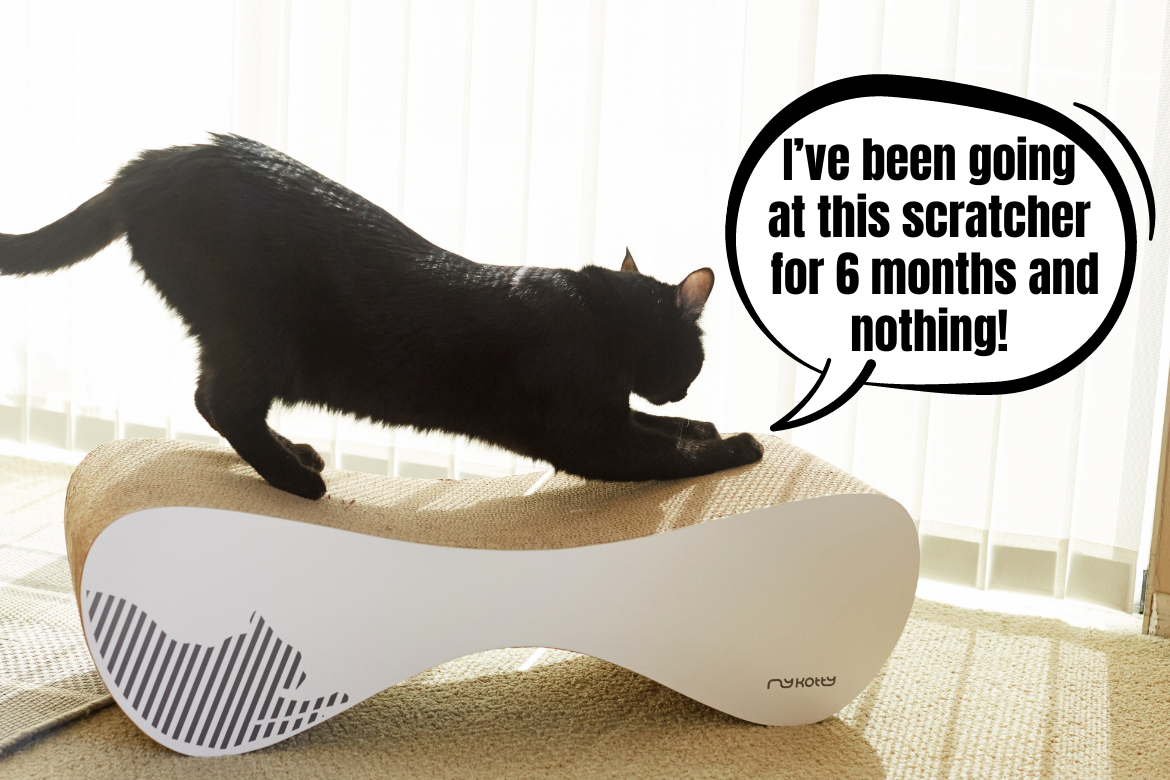Scratching is as natural for cats as it is to go to the litter box, chase flies, and stick fur to every surface possible – it’s an inherent part of a cat’s life. Cats scratch to mark their territory, stretch out, strengthen their muscles and sharpen their claws. And they’re experts in that! If we don’t want our furniture to fall victim to cat claws, giving them proper scratchers is a must – you, fabCats, know all about it. But did you ever wonder if there are cats who simply don’t scratch? And if lack of scratching behaviors should be worrying for us, cat Carers? Come with us and find out!
A cat is a cat – they must scratch
Why do cats scratch our furniture, scratchers, door frames, and anything they find in their way? It’s an instinct that’s perfectly normal to both domestic cats and their wild ancestors. Vertically, horizontally, at an angle, on the couch, the carpet, the door frame, and a tree – cats scratch anywhere they want to leave their scent mark and where they feel safe to stretch out without pulling the scratched thing down on themself. The matter of safety is non-negligible when it comes to choosing the right scratcher and the spot to put it in:
- A good scratcher is heavy and sturdy enough to let the cat grab it and scratch with force. In terms of vertical scratchers, if the base is not heavy enough, the scratcher could tip over and fall onto the cat – it’s obvious that in this scenario, the couch is much better than the scratcher! For horizontal scratchers, a more important factor is the size (so the cat can comfortably sit on it and brace with their back paws) and the weight, just so the cat doesn’t tip it over while sitting down or scratching.
- The placement of the scratcher shouldn’t be random because if it is supposed to serve as a marking spot, it has to stand in spaces that are key to household life. The cat is scratching the couch because that’s where they smell the scent of their hoomans and want to show that they’re also part of the family. A scratcher set up in a far corner of the house isn’t able to serve this purpose – the couch will still suffer and the scratcher will serve as a comfy bed at best.
More on where to set up a scratcher to make it a hit with the cats:
Scratching serves one more purpose: it helps cats to keep their claws in the best shape. Contrary to popular opinion, it doesn’t hone down the nails – it lets the cat shed the outer layer of the claw to reveal a fresh, sharp one. By regularly trimming the cat’s claws, they will be less of a threat to you, your furniture, the scratchers, and the cat themself – if we don’t do this and the cat doesn’t manage to shed the outer layer, the claws may grow too long, dig into the paw pads, or injure the cat when they scratch and groom themself. Let’s remember that for later as we will be going back to this topic.
When a cat stops scratching
Unfortunately, it can happen and it’s not a good sign. After all, scratching is one of the cats’ ways of showing happiness! If you ever noticed your cat welcoming you home by jumping up onto the scratcher and stretching out, now you know it’s just their way of showing pure joy. And when a cat gives up on something as important and natural for them, it’s a clear sign something’s not right. Stress, injuries, illness – there are many reasons a cat could stop scratching and that’s why it’s necessary to watch our cats closely and consult with the vet right away to minimize any suffering our cats may experience.
When you don’t know if your cat is scratching. It’s not a reason to panic. Your cat may be scratching when you don’t see it – if you’re going to work for long hours and your cat sleeps most of the time you are at home, you may be thinking they’re not scratching much if at all. You need to try and see if they’re actually interested in scratching. When playing, direct their attention to a scratcher and let them stretch out. You could scratch the surface yourself – many cats actually love it and want to scratch immediately. When you’re out of the house, you could set up a camera to see the scratcher and make sure your cat isn’t avoiding them. Because if they do…
Find out the reasons your cat might be avoiding the scratcher
Cats might stop scratching when they’re stressed out, scared, or in physical pain. When the cause is stress, the solution is to eliminate the source of it and prepare a space where the cat can slowly get used to the surroundings and mark it as their own by scratching. However, sometimes the reasons are more physical, and cats, known for their talent to hide any pain, won’t let us know that something’s clearly going on. The reasons for a cat to stop scratching may include:
- atrophies and joint pains which can apply to both older cats and many younger ones who might have genetic predispositions to some health issues. Arthritis and other joint atrophies can cause pain while walking so it’s no surprise scratching wouldn’t be the most pleasant experience either.
- Injuries. If a cat hurts their paw, lands improperly after a jump, or catches their claw on the couch and injures it, not being able to free the paw, they likely won’t be happy to scratch and cause themselves more pain. If the injury doesn’t happen in our presence, we might not realize it happened at first. But when a cat stops scratching, it’s good to check out their paws and claws to make sure. A visit to the vet to get an RTG and find the source of pain.
- claw issues. Scratching requires having claws and if the cat isn’t scratching, it’s worth looking for the problem right there. And there may be many of those – from broken claws, bacterial infections, and fungal infections to claws growing into the paw pad, blisters, and other skin issues. To diagnose and treat them, you’ll need to visit the vet – injuries around a cat’s paws cause problems not only with scratching but also with using the litter box or moving around.
One of the obvious reasons for a cat to stop scratching might be… a bad scratcher. If the cat is avoiding it like the plague, there is a possibility that the sisal rope or the cardboard it’s made out of is too harsh on the paws or the scratcher doesn’t meet the cat’s needs. We’ve said more about the parameters of a perfect stretcher at the beginning. If you feel like the scratchers are the problem for your cats, here at myKotty we do everything in our power to make our scratchers fully safe and cat-paw-friendly. That’s a good starting point!
What to do if your cat isn’t scratching?
It’s not something we should ignore – a healthy cat will always scratch as it’s their nature just like it is to nap, eat, or use the litter box. If you are worried about the lack of such a crucial part of a cat’s behavior, you can go to the vet straight away or, just to limit the list of possible causes, try to encourage your cat to scratch. How?
- get them a new scratcher (Spring sales are on at → https://www.mykotty.eu/)
- place the scratcher in a new spot – by the couch, your bed, on the entryway to the living room, or even in the center of the room. Cat’s curiosity should make them want to explore the sudden change.
- use catnip or valerian – cats who love the magic herbs will definitely appreciate this form of encouragement.
- direct your cat’s attention to the scratcher during playtime. Take their favorite string, feather, or other toy and play with your cat around the scratcher or directly on top of it.
If none of the ways works and you didn’t see your cat get naturally curious about the scratcher, check their paws (if your cat lets you touch them), check their claws, and let your vet know about your observations. The key is to quickly find the cause of the issue to end your cat’s suffering.
Have your cats had health issues that stopped them from scratching? We want to hear your stories – share them in the comments or join the discussion over on Facebook → https://www.facebook.com/myKottypl




